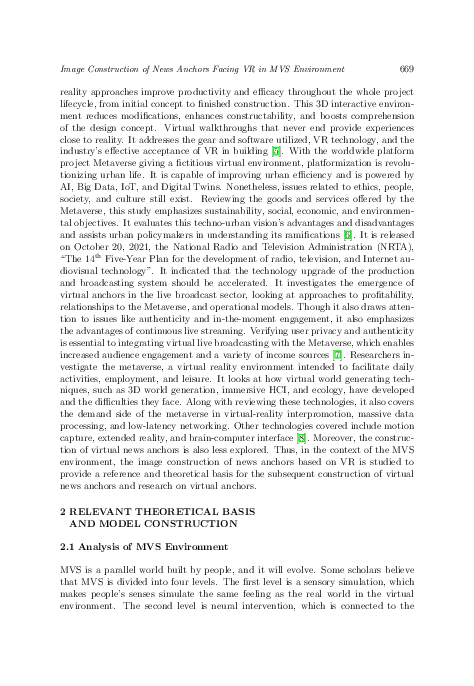Image Construction of News Anchors Facing Virtual Reality in the Metaverse Environment
keywords: Metaverse, virtual reality, virtual anchor, image construction, visual architecture
With the continuous improvement of communication and computing technology, the technical threshold of the Metaverse (MVS) has been lowered, gradually expanding the scope of technology penetration, and attracting attention to the construction of characters in the MVS environment. In virtual reality (VR), character design and scene realizations are the foundation and guarantee of technology application. VR also provides an effective tool for the transformation of traditional media and the exploration of news communication innovation. On this basis, firstly, the introduction of VR is analyzed in the MVS environment. Secondly, based on the application status of VR, the modeling design and structure optimization of three-dimensional (3D) characters in the MVS environment are studied. Furthermore, by improving the traditional 3D modeling process, an adaptive hierarchical detail model is proposed to realize the scene modeling mechanism of the virtual environment combining image modeling and geometric modeling, so as to quickly complete the construction of the character image model of a news anchor in the scene. Finally, the model of the experimental design is simulated and constructed to test the effect of the model to construct the image of news anchors. The results reveal that the frame rate of news anchor images designed by the model can be kept at about 40 frames per second. The actual value of modeling details is always greater than the ideal value of modeling design. By comparing the actual modeling time of the control group and the experimental group, it can be found that the modeling time of the experimental group is shorter. Therefore, it can be concluded that the VR-based hierarchical detail model in the MVS environment designed in this research can better complete the image construction of news anchors. The research results can provide a reference and theoretical basis for the subsequent modeling work in the MVS environment and the construction of VR characters.
reference: Vol. 43, 2024, No. 3, pp. 667–686


